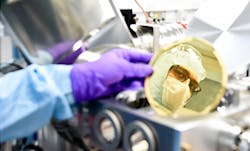New phase‐change material for reconfigurable photonic devices has very low loss
Optical phase‐change materials, which can be used in reconfigurable photonic devices such as integrated photonics, nanophotonics, and optical metasurfaces, produce a reversible phase change useful for switching; however, conventional phase‐change materials made from chalcogenides are lossy. Researchers from the University of Southampton (UK) have now demonstrated a new material family including antimony trisulfide (Sb2S3) and antimony triselenide (Sb2Se3) that leads to phase‐change materials that exhibit very low loss at telecommunication wavelengths and be switched with very low power.1 The technology is compatible with existing silicon photonic circuits.
Researchers Matthew Delaney and Ioannis Zeimpekis pinpointed a material structure and composition that enables high transparency while exhibiting low-power modulation of light, finding that the new composition has 100 times less loss than the current state-of-the-art optical materials.
No power needed to remember its state
Their material was deposited on top of optical chips, where a short laser pulse was used to crystallize the material and change the phase of the guided light. The researchers demonstrated this property reversibly thousands of times. Importantly, the material remembers its last state without any applied signals, leading to large potential power savings.
“This new technology will simplify and enable newly emerging applications such as solid-state lidar, quantum, and neuromorphic computing that are currently limited by the performance of the existing materials,” says Otto Muskens, head of the University's Integrated Nanophotonics group. “Neuromorphic and programmable photonics are set to revolutionize the industry as they offer new paradigms for data processing going far beyond existing hardware. Quantum optical circuits are on the horizon and ultralow-loss components are needed to make the next step in controlling and routing quantum information.”
The team is currently working to create more photonic-circuit components with the aim to design a neuromorphic computing photonic chip with in-memory computing capabilities. It is expected that this method will replace current technologies within the next couple of years, enabling a leap forward for the technology of photonic computing.
Source: https://www.phys.soton.ac.uk/news/6758
REFERENCE:
1. Matthew Delaney et al., Advanced Functional Materials (2020); https://doi.org/10.1002/adfm.202002447.

John Wallace | Senior Technical Editor (1998-2022)
John Wallace was with Laser Focus World for nearly 25 years, retiring in late June 2022. He obtained a bachelor's degree in mechanical engineering and physics at Rutgers University and a master's in optical engineering at the University of Rochester. Before becoming an editor, John worked as an engineer at RCA, Exxon, Eastman Kodak, and GCA Corporation.
